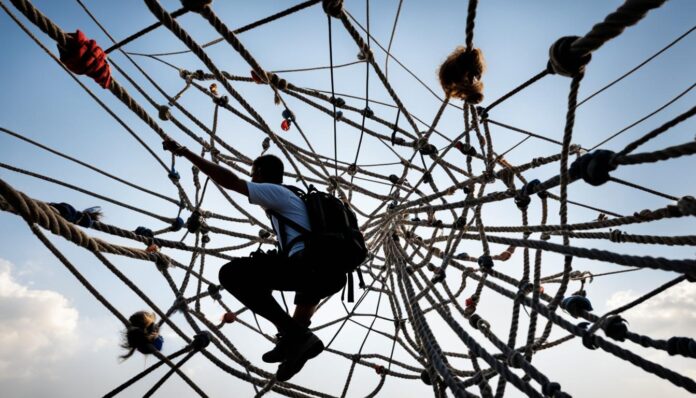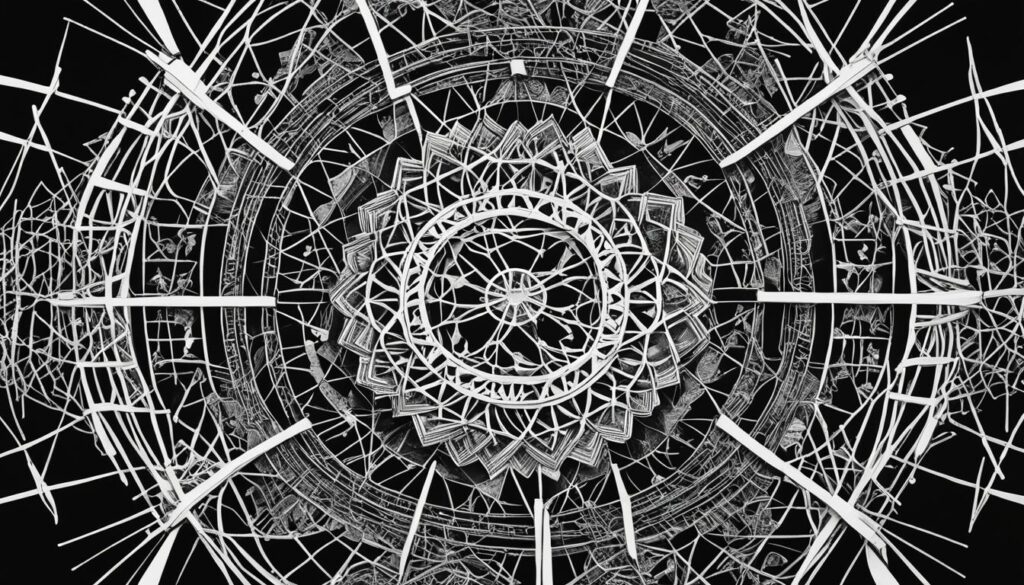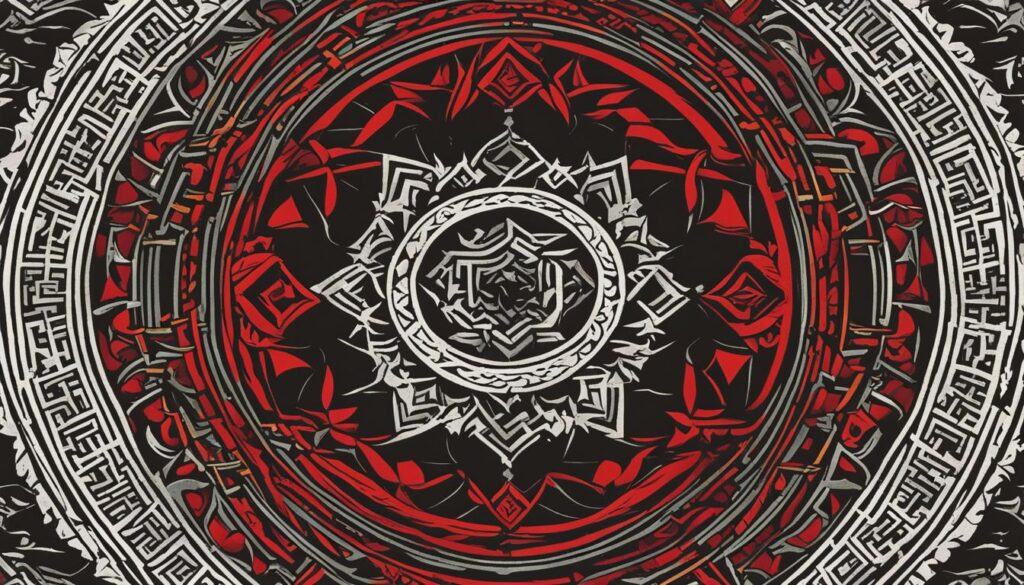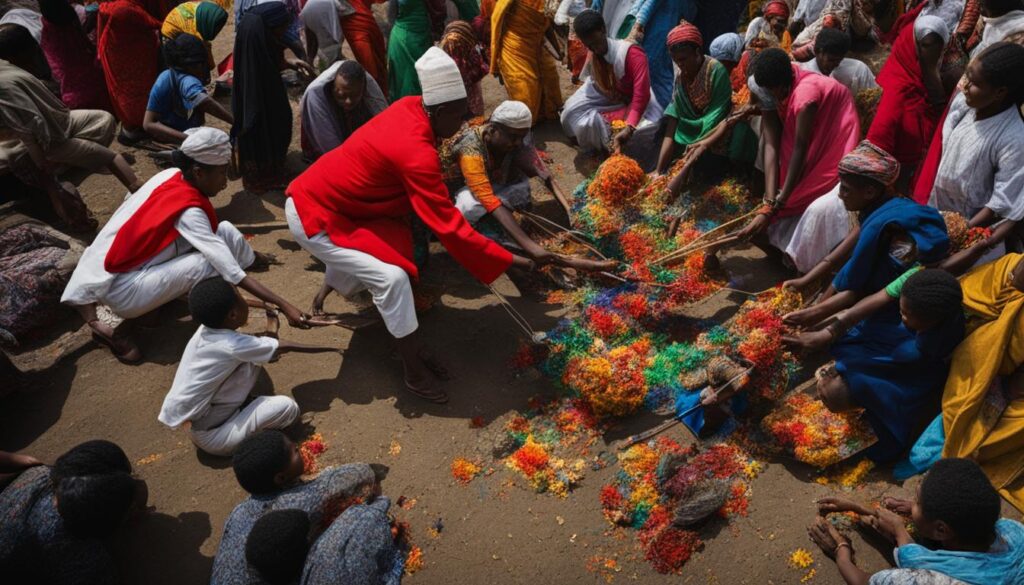Welcome to our exploration of understanding cultural hierarchies and power dynamics. In this section, we’ll dive into how these concepts shape society and social interactions. By developing a better comprehension of cultural hierarchies, we can effectively navigate various cultural and social structures and ultimately create a fairer and more equitable society.
Power dynamics analysis is an essential component of understanding cultural hierarchies. It enables us to examine how power relations operate within different cultures and contexts. This knowledge allows us to acquire a more profound understanding of the inequalities and power imbalances in our society. Understanding cultural hierarchy exploration also allows us to identify situations where power is being exerted and find ways to challenge these dynamics.
Let’s begin by exploring the definition of cultural hierarchies and how they manifest in different societies. Understanding cultural dynamics and power structures is critical in comprehending how these hierarchies operate.
Defining Cultural Hierarchies
Understanding cultural dynamics is crucial when it comes to comprehending social interactions and power structures. Cultural hierarchies are present in societies worldwide and have a potent impact on individuals and communities. When examining cultural hierarchies, it is essential to understand the significance of cultural power structures and how they create and reinforce hierarchical systems.
Cultural hierarchies are complex systems that dictate how society interacts with different groups based on race, gender, class, and other identities. Cultural power structures determine the distribution of resources and opportunities, often in favor of those who hold privileged positions within the system.
Exploring cultural power structures provides insights into how different groups interact with one another and the impact of these interactions. For instance, if men hold the majority of positions of power in a given society, women may experience prejudice and stereotyping.
The image below illustrates the concept of cultural hierarchies and power dynamics. It shows how power and influence flow through society, often benefiting those at the top of the hierarchy.
“Cultural hierarchies and power dynamics play a significant role in shaping social interactions and shaping the society we live in.”
Unpacking Power Dynamics
At the core of cultural hierarchies is the concept of power dynamics. Power is a pervasive force that shapes social interactions and relationships in various ways. A thorough power dynamics analysis encompasses an understanding of how differences in societal power dynamics, cultural dynamics, individual power dynamics, and group power dynamics interconnect with one another.
When we talk about power dynamics within cultural settings, it is important to note that power can manifest in different forms.
Cultural Dynamics Understanding
One form of power is the power of culture. Cultural power dynamics exist within the beliefs, customs, and traditions of a society. It can be seen in how society rewards certain behaviors and punishes others, how it sanctions certain standards of beauty and punishes those who deviate from these standards.
By having a cultural dynamics understanding, we can recognize how culture shapes our beliefs and perceptions. This awareness allows us to question and evaluate cultural norms that may not align with our values of inclusion and equity.
Societal Power Dynamics Understanding
Another form of power is societal power. Societal power dynamics are rooted in the structure and organization of a society. The distribution of resources, opportunities, and political power are all examples of societal power dynamics.
A societal power dynamics understanding enables us to recognize and challenge systems of inequality and oppression within society.
Power Dynamics Analysis
Individual power dynamics and group power dynamics alike are also crucial in understanding power dynamics. Power struggles between individuals and among groups play a role in the shaping of cultural hierarchies and power dynamics.
Power dynamics analysis involves examining the ways in which power is exerted, maintained, and challenged at different levels within a given cultural structure. By developing an awareness of power dynamics, we can navigate through cultural hierarchies more effectively and work towards creating more equitable and just societies.
“Power is not given; it is taken”— Beyoncé
Exploring Social Dominance
Social dominance refers to the ways in which power is exerted and maintained within society. It is closely tied to cultural hierarchies and is a significant factor in shaping group and individual identities.
By exploring social dominance, you can gain a deeper understanding of how power dynamics function within cultural contexts. This will enable you to better comprehend the ways in which social structures impact marginalized groups and foster inequality.
For example, consider the wage gap between men and women in the United States. This is an illustration of social dominance at play; men are often considered the dominant group within society and have historically held more power and resources than women.
By examining social dominance and its relationship with cultural hierarchies, we can begin to work towards creating a more equitable and just society. This involves actively challenging power imbalances and fostering social awareness and empathy.
Unequal Power Structures
Unequal power structures are a key feature of social dominance. These structures often reinforce existing cultural hierarchies, with marginalized groups consistently having less access to power and resources.
| Group | Typical Stereotypes | Power Status |
|---|---|---|
| White People | Intelligent, capable leaders | Typically hold more power and access to resources |
| People of Color | Lazy, inferior | Typically marginalized and have less access to power and resources |
| Men | Tough, rational leaders | Typically hold more power and access to resources |
| Women | Emotional, weak | Typically marginalized and have less access to power and resources |
“The most common way people give up their power is by thinking they don’t have any.” – Alice Walker
Understanding social dominance and cultural hierarchies is crucial when striving for greater equality and inclusivity. By acknowledging unequal power structures and actively working towards dismantling them, we can create a more just and equitable society.
Examining Intersectionality
Understanding power dynamics and cultural hierarchies requires a nuanced understanding of individual and intersecting identities. The concept of intersectionality recognizes that people are controlled by more than one axis of oppression, such as race, gender, class, and sexuality. By examining these intersections, we can gain a more comprehensive understanding of how power operates in society.
For example, someone who identifies as a Black, transgender woman may experience higher levels of discrimination and marginalization than a white, cisgender woman. This is due to the intersection of their various identities and the ways in which they interact with cultural hierarchies.
In order to effectively analyze power dynamics, we must take into account the various intersecting factors that contribute to oppression. By doing so, we can better understand the complexities of power relationships and work towards creating more equitable and just systems.
| Identity | Privilege | Oppression |
|---|---|---|
| White, cisgender man | Male privilege, white privilege | N/A |
| Black, transgender woman | N/A | Racial discrimination, gender discrimination, transphobia |
| Latina, low-income, queer person | N/A | Racial discrimination, class discrimination, homophobia |
How Intersectionality Shapes Power Dynamics
Intersectionality plays a crucial role in shaping power dynamics and cultural hierarchies. By acknowledging and analyzing the ways in which identities intersect, we can gain a deeper understanding of how power operates in society. This allows us to identify the ways in which certain identities are privileged or disempowered in different contexts.
For example, an individual may have privilege in one context due to a specific identity, but experience oppression in another due to a different identity. By understanding the intersectionality of their identities, we can better comprehend the complexities of their experiences and work towards creating more equitable and just systems.
Overall, examining intersectionality is a crucial step in understanding power dynamics and cultural hierarchies. By recognizing the ways in which intersecting identities contribute to oppression and inequality, we can work towards creating a more just and inclusive society.
Navigating Power Dynamics in Everyday Life
Now that you have an understanding of cultural hierarchies and power dynamics, it is essential to know how to navigate them in your daily life. Here are some practical strategies to challenge power imbalances:
Create Meaningful Connections
Building meaningful connections with people from different cultural and social backgrounds can help you gain a more profound understanding of power dynamics. Take the time to get to know others and ask genuine questions about their experiences.
Challenge Your Biases
We all possess biases shaped by our cultural and social experiences. Recognizing your biases and actively working to challenge them is essential to creating more equitable relationships.
Empower Marginalized Voices
Listen to and amplify the voices of marginalized groups in your community. Attend events, read literature, and support the work of individuals and organizations that work towards social equity.
Be Mindful of Language
Be mindful of the language you use and the power dynamics it reinforces. Avoid using language that is exclusive or oppressive towards certain groups.
Challenge Inequitable Systems
Challenge inequitable systems whenever possible, whether it’s in your workplace or community. Engage in critical conversations and advocacy efforts to raise awareness and create change.
Deconstructing Cultural Norms and Stereotypes
Cultural norms and stereotypes often perpetuate existing power dynamics, reinforcing cultural hierarchies and marginalizing certain groups. It’s essential to critically examine and break down these norms and stereotypes to create a more inclusive and equitable society.
One way to challenge cultural norms and stereotypes is by promoting representation and diversifying media. By providing a platform for diverse voices and experiences, we can break down harmful stereotypes and narratives that have historically been perpetuated by those in power.
Another crucial step is to interrogate our own biases and assumptions about different cultural groups. By acknowledging and challenging these prejudices, we can reduce the impact of negative cultural stereotypes and promote greater empathy and understanding.
“The most common way people give up their power is by thinking they don’t have any.” – Alice Walker
Ultimately, deconstructing cultural norms and stereotypes is a long-term process that requires a deep understanding of power dynamics and cultural hierarchies. By committing to this ongoing work, we can cultivate a more just, inclusive, and empathetic society for all.
Addressing Power Dynamics in Institutions
Institutions, whether governments, corporations, or other large organizations, have significant influence over societal power dynamics. Examining and addressing power imbalances within these institutions is crucial for creating a more equitable society. One way to do this is to promote cultural dynamics understanding and power dynamics analysis within the institution. By encouraging individuals to critically examine their own biases and power dynamics, organizations can work towards creating more equitable systems.
A key aspect of addressing power dynamics in institutions is promoting awareness of societal power dynamics understanding. This involves recognizing the ways in which cultural hierarchies and power imbalances impact marginalized groups and individuals. It also involves identifying and challenging institutional policies and practices that may perpetuate these power imbalances.
Another critical step is promoting diversity and inclusion within institutions. This means actively seeking out and supporting individuals from diverse backgrounds, and creating an inclusive workplace culture where everyone feels valued and heard. It also involves reevaluating hiring practices and institutional policies to ensure that they promote diversity and equity.
“In order to address power imbalances within institutions, it’s important to first acknowledge that they exist. Only then can concrete steps be taken to promote equity and inclusion.”
To address power dynamics in institutions effectively, it’s essential to involve stakeholders from different levels within the organization. This means engaging in transparent communications and actively working towards building consensus around actions that promote equity and inclusion.
Promoting Cultural Understanding and Empathy
Cultivating cultural understanding and empathy is crucial in breaking down cultural hierarchies. By prioritizing a deep appreciation for different cultures and their unique dynamics, you can begin to dismantle ingrained biases and foster greater respect and understanding between people from all walks of life. Here are some ways you can promote cultural understanding and empathy:
- Education: You can improve your understanding of cultural hierarchies and power dynamics by engaging in a range of educational experiences. Take courses that explore cultural dynamics, read books by authors from diverse backgrounds, and attend cultural events.
- Empathy-Building Practices: Practicing empathy is key in developing a deeper awareness of other people’s experiences. Try putting yourself in other people’s shoes, actively listening to their perspectives, and approaching conversations with an open mind.
- Cross-Cultural Dialogue: Engaging in cross-cultural dialogue is an excellent method to learn from different cultures. Find ways to join conversations where people from different backgrounds meet and have open-minded discussions without judgment.
The more you promote cultural understanding and empathy, the more you cultivate an inclusive, equal, and empathetic society.
Conclusion
Congratulations on completing this exploration of cultural hierarchies and power dynamics. By gaining a deeper cultural dynamics understanding, you can navigate social interactions more effectively, identifying power dynamics analysis points along the way. Remember, by understanding these dynamics, you can work towards creating a more inclusive and equal society.
Always keep in mind that social dominance, cultural hierarchy exploration, and understanding power dynamics analysis are complex concepts that require ongoing education and empathy-building practices. Whether you are examining power dynamics within institutions or challenging cultural norms and stereotypes, your continued efforts towards understanding cultural hierarchies and power dynamics are essential.
So keep learning, keep challenging yourself, and keep striving towards a more inclusive and empathetic world, one that values cultural dynamics understanding and power dynamics analysis. With continued effort and education, you can make a difference in your everyday life and contribute to a more equitable society.

















































